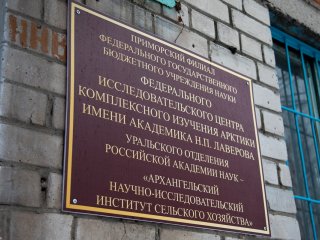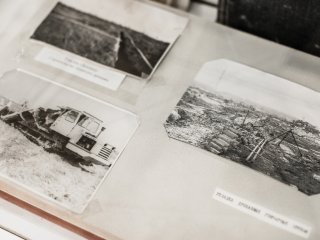Scientific Russia visited Arkhangelsk and met with Oleg Dmitrievich Kononov: Corresponding Member of the Russian Academy of Sciences, Advisor to the Director of the N. Laverov Federal Center for Integrated Arctic Research of the Ural Branch of the Russian Academy of Sciences, Doctor of Agricultural Sciences. We talked about the Arctic tundra, reclamation science, and the shortage of personnel in agriculture.
─ Oleg Dmitrievich, the Arkhangelsk Oblast is located in an area of excessive moisture, it basically stands on swamps. What is being done to eliminate excessive moisture, how is agriculture developing in these conditions?
─ Yes, indeed, our soils are excessively moistened. This is due to the flat terrain and weak water permeability of the underlying rocks, the excess of precipitation over evaporation. There is a lot of water, a lot of swamps, and there is virtually no dry agricultural land in the region. All our farmland mainly requires reclamation, that is, drainage.
The development of agriculture in the north of Russia began a very long time ago since the development of this territory by Novgorod settlers at the end of the tenth century. But there was no reclamation science as such until 1914. Then, at the numerous requests of the peasants, the first scientific institution on land drainage was created in the region – the Arkhangelsk Experimental Land Reclamation Station. It was endowed with a land plot of 403 hectares for scientific purposes, which was drained by various types of drainage: wooden, ceramic, plastic drainage, with different distances between drains, with different drain diameters so that it could be studied which type of drainage or which method of drainage is more effective. The study of the effectiveness of drainage was carried out on floodplain lands. Why on the floodplain? Because floodplain lands are the most fertile for agricultural development and their area is more than 30% of agricultural land. This successful experience was then spread across the agricultural enterprises of the region.
Reclamation science was also needed during the construction of the city of Arkhangelsk. At this time, Arkhangelsk has already begun to build up and develop. The construction took place in a heavily swampy area and reclamation science was extremely necessary here. Initially, all the streets of Arkhangelsk were plank because it was impossible to lay asphalt in the swamp. The same goes for houses. Even now, walking around Arkhangelsk, you can see old wooden houses and sidewalks – a legacy of that time.
Scientists of the Experimental Reclamation Station studied swamps in their natural state, engaged in the agricultural development of drained swamps; peat of the riding swamps was often used for fertilizers and as bedding for livestock. It can be said that agricultural science in the region originates since then. Reclamation science is very important for our region. The need for such scientific research is still very relevant today.
─ And is land reclamation being carried out now?
─ No, unfortunately, reclamation is not being carried out now. To date, 84 thousand hectares of land have been drained in the Arkhangelsk Oblast. Due to the perestroika in the 1990s and the agricultural reform, most of the large agricultural enterprises in the region were liquidated, and the need for such active land use, as before, disappeared. Unused lands have appeared, which, unfortunately, are now empty, overgrown with weeds and forest shrubs. To bring these lands into proper shape, large financial investments are needed. It is necessary to repair the drainage network, to carry out radical land improvement, which includes a huge amount of work. It is a pity that the investments in the reclamation construction of facilities do not give a return now. However, I’m sure that over time we will still return to the revival of land reclamation in the region because agriculture cannot develop effectively in the North without land reclamation science.
─ What area of the Arkhangelsk Oblast is occupied by swamps today?
─ Swamps account for about 20% of the entire territory of the Arkhangelsk Oblast. In some areas, they vary up to 50% or more. Swamps are divided into upland, lowland, transitional: in our region, the largest percentage falls on upland swamps. Their structure is such that they have a litter of about 30 centimeters, and then there is slightly decomposed peat, which can be used as bedding for animals, as well as for heating. In some areas of our region, such work has already been carried out: peat was harvested, from which briquettes were pressed and supplied for heating industrial and residential buildings. And our famous cloudberries and cranberries grow on the upland swamps of the Arkhangelsk Oblast – these are very tasty and healthy berries.
─ The local tundra is very susceptible to erosion processes. How сan this issue be solved?
─ Indeed, erosive processes in the tundra are a big problem. Tundra vegetation is very vulnerable. Its surface vegetation layer is very weak, and, for example, even one passage of tracked vehicles is enough to destroy it, and it will take decades to recover.
Now a lot of attention is being paid to Arctic territories all over the world because the Arctic contains large reserves of hydrocarbons and minerals. Oil rigs, shift settlements, pipelines, roads, and sideways began to be built. For this reason, tens and hundreds of hectares of land come out of usage as deer pastures every year, and the self-restoration of damaged lands takes a lot of time. Oilmen are responsible for soil disturbance in the Arctic tundra zone. Therefore, they are forced to turn to scientists to solve the issues of reclamation of disturbed lands. As a result of ongoing scientific research on this topic, we have concluded that disturbed lands can be restored by biological reclamation. This solution was proposed by us as the main one.
─ How does this land reclamation take place?
─ It is possible to restore the damaged soil layer only by meadowing, that is, by sowing perennial grasses on these areas. In particular, for these purposes, varieties of perennial grasses resistant to extreme Arctic conditions are being created at the Kotlas Agricultural Experimental Station. These are, for example, such herbs as meadow fescue, red fescue, orchard grass, timothy, etc.
The best variety of such perennial herbs grown at the Kotlas Agricultural Station is, perhaps, red fescue. It has already been sown in the Arctic, where permafrost thaws only its upper layer, and it took root very well, there was a rapid meadowing of the disturbed areas.
─ And do these new grasses not interfere with the growth of the native tundra vegetation?
─ No, on the contrary: in the conditions of such artificial meadowing, local grass populations began to grow even faster. In general, this is a very big and painstaking job. Of course, perennial herbs are selected in such a way that they do not interfere, but, on the contrary, help the native flora recover faster.
─ How many hectares of the tundra have you already restored?
─ Currently, more than 7000 hectares of the tundra have been disturbed in the NAO. Biological reclamation has so far been carried out on an area of about 1000 hectares. So, there is still a lot of work to be done.
─ Which tundra vegetation is most valuable?
─ Reindeer eat a significant part of wild plants of various species growing in the tundra. There are more than 500 species. The main feeds used by reindeer are divided into forage lichens, fodder plants that have a set of all the nutrients necessary for animals, as well as mushrooms. In summer, reindeer feed on grass, and in winter they switch to lichen.
─ Speaking of reindeer. Is it true that there is an acute shortage of specialists in scientific work with reindeer?
─ Not that there is a shortage, there are none at all. I mean, first of all, specialists for scientific work on improving reindeer herding. This is the profile of a zoo technician, a veterinarian with a specialization in reindeer herding. You can’t get such ready-made specialists anywhere because no one teaches them: no university trains professional reindeer herders. Working conditions in the tundra are very harsh and uncomfortable – it’s not easy to lure a young specialist there.
─ Are there not enough reindeer herders too?
─ Yes, there is a shortage of them too. In modern realities, when industrial enterprises came to the tundra, the Nenets, for example, are already gradually moving away from reindeer herding. They don’t want to live in the chum anymore, they want to live in the city, in apartments, and the oil companies, in turn, provide them with all this. Therefore, reindeer herders are now very difficult to find. You see, life is very difficult in the tundra because herders must constantly roam. Reindeer herders do not live sedentarily but move all the time. To build a chum in a different place every time, to monitor a large herd of reindeer, to lay routes in the snow-covered tundra is a very hard and difficult job, besides it is not highly paid at all.
Now a completely different generation of people has grown up. Previously, the profession of reindeer herder was passed down from generation to generation in the same family, the Nenets had an understanding that reindeer herding was their main trade. Today, the world provides many other opportunities, so reindeer herding is much less common. And if you just bring a person who does not know the tundra and appoint them a reindeer herder, then most likely nothing good will come of it. For this profession, a person must be born and grow up in the tundra to do this job well.
─ Is this trend observed only in Russia?
─ No, I think there is a shortage of reindeer herders all over the world right now. Young people do not want to go into this profession. How to attract them? This is a very big problem.
─ And what about agriculture in general?
─ In general, I can say that there is also a shortage of agriculture specialists: In fact, there are no agronomists left. Well, young people do not go to study to be agronomists.
Agronomists perform a variety of activities related to agriculture and have comprehensive knowledge in this field. They are engaged in seed production, cultivation of crops, greenhouse farming, etc. It is impossible to grow any crop and get a good harvest without an agronomist. Therefore, I really hope that in the near future such agriculture specialists will still emerge.

































